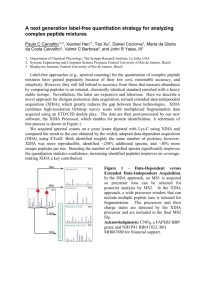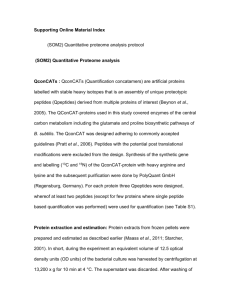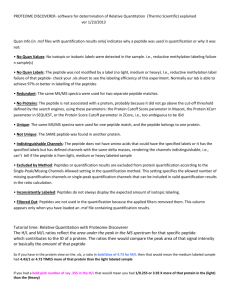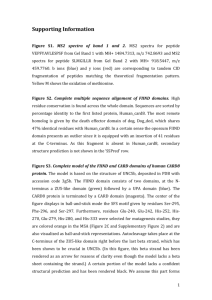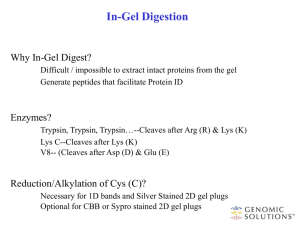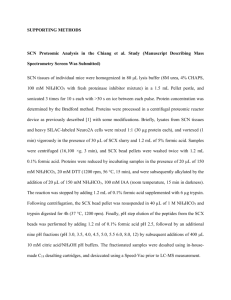pmic7818-sup-0004-SupMat
advertisement
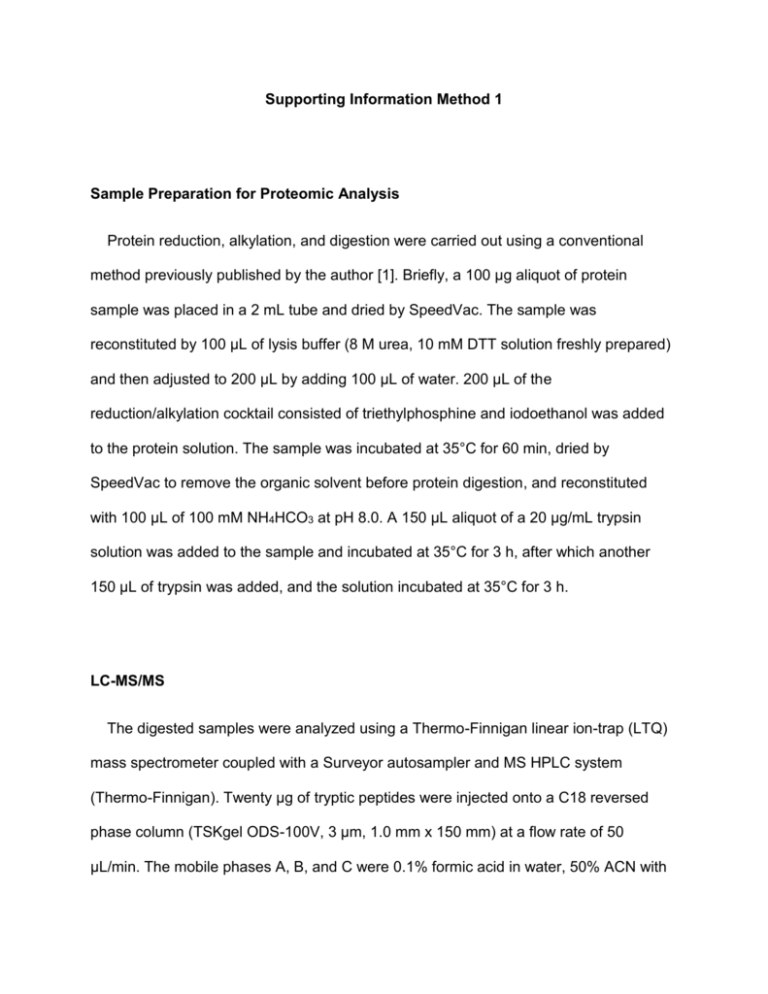
Supporting Information Method 1 Sample Preparation for Proteomic Analysis Protein reduction, alkylation, and digestion were carried out using a conventional method previously published by the author [1]. Briefly, a 100 µg aliquot of protein sample was placed in a 2 mL tube and dried by SpeedVac. The sample was reconstituted by 100 µL of lysis buffer (8 M urea, 10 mM DTT solution freshly prepared) and then adjusted to 200 µL by adding 100 µL of water. 200 µL of the reduction/alkylation cocktail consisted of triethylphosphine and iodoethanol was added to the protein solution. The sample was incubated at 35°C for 60 min, dried by SpeedVac to remove the organic solvent before protein digestion, and reconstituted with 100 µL of 100 mM NH4HCO3 at pH 8.0. A 150 µL aliquot of a 20 µg/mL trypsin solution was added to the sample and incubated at 35°C for 3 h, after which another 150 µL of trypsin was added, and the solution incubated at 35°C for 3 h. LC-MS/MS The digested samples were analyzed using a Thermo-Finnigan linear ion-trap (LTQ) mass spectrometer coupled with a Surveyor autosampler and MS HPLC system (Thermo-Finnigan). Twenty µg of tryptic peptides were injected onto a C18 reversed phase column (TSKgel ODS-100V, 3 µm, 1.0 mm x 150 mm) at a flow rate of 50 µL/min. The mobile phases A, B, and C were 0.1% formic acid in water, 50% ACN with 0.1% formic acid in water, and 80% ACN with 0.1% formic acid in water, respectively. The gradient elution profile was as follows: 10% B (90% A) for 7 min, 10-67.1% B (9032.9% A) for 163 min, 67.1-100% B (32.9-0% A) for 10 min, and 100-50% B (0-50% C) for 10 min. The data were collected in the “Data dependent MS/MS” mode with the ESI interface using normalized collision energy of 35%. Dynamic exclusion settings were set to repeat count 1, repeat duration 30 s, exclusion duration 120 s, and exclusion mass width 0.60 m/z (low) and 1.60 m/z (high). Protein Identification and Quantification The acquired data were searched against UniProt protein sequence database (released on April 3, 2013) using SEQUEST (v. 28 rev. 12) algorithms in Bioworks (v. 3.3). General parameters were set to: mass type set as “monoisotopic precursor and fragments”, enzyme set as “trypsin(KR)”, enzyme limits set as “fully enzymatic - cleaves at both ends”, missed cleavage sites set at 2, peptide tolerance 2.0 amu, fragment ion tolerance 1.0 amu, fixed modification set as +44 Da on Cysteine, and no variable modifications used. The searched peptides and proteins were validated by PeptideProphet[2] and ProteinProphet[3] in the Trans-Proteomic Pipeline (TPP, v. 3.3.0) (http://tools.proteomecenter.org/software.php). Only proteins and peptides with protein probability ≥ 0.9000 and peptide probability ≥ 0.8000 were reported with FDR < 5%. After TPP validation, proteins identified by one peptide were included. Protein quantification was performed using a label-free quantification software package, IdentiQuantXLTM.[4] References [1] Lai, X., Bacallao, R. L., Blazer-Yost, B. L., Hong, D., et al., Characterization of the renal cyst fluid proteome in autosomal dominant polycystic kidney disease (ADPKD) patients. Proteomics Clin. Appl. 2008, 2, 1140-1152. [2] Keller, A., Nesvizhskii, A. I., Kolker, E., Aebersold, R., Empirical statistical model to estimate the accuracy of peptide identifications made by MS/MS and database search. Anal. Chem. 2002, 74, 5383-5392. [3] Nesvizhskii, A. I., Keller, A., Kolker, E., Aebersold, R., A statistical model for identifying proteins by tandem mass spectrometry. Anal. Chem. 2003, 75, 4646-4658. [4] Lai, X., Wang, L., Tang, H., Witzmann, F. A., A novel alignment method and multiple filters for exclusion of unqualified peptides to enhance label-free quantification using peptide intensity in LCMS/MS. J. Proteome Res. 2011, 10, 4799-4812.



